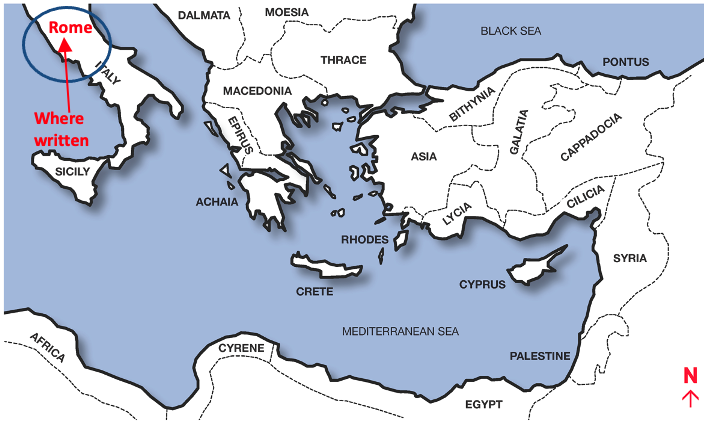2nd Peter
Beware of False Teachers
Summary | About | Why You Should Read it | Author | When Written | Context | Timeline | Location | Outline | Observations | Resources
Summary
2 Peter is a New Testament epistle traditionally attributed to the Apostle Peter, written as a final message to believers, urging them to remain steadfast in their faith and to be wary of false teachers. The letter focuses on spiritual growth, the dangers of false teachings, and the certainty of Christ’s return.
The table below is a high-level look at the structure and contents of 2nd Peter.

About
2nd Peter is the 22nd book of the New Testament and the 61st book of the Bible.

Why You Should Read It
2 Peter serves as a powerful reminder to believers to remain vigilant in their faith, grow in spiritual maturity, and hold firmly to the truth of the gospel. It warns against the dangers of false teachers and emphasizes the importance of living a life that reflects the hope of Christ’s return. The letter encourages Christians to stay grounded in their faith and to persevere until the end, looking forward to the fulfillment of God’s promises.
Author
The author of 2nd Peter is the Apostle Peter, whom Jesus personally selected to be a “fisher of men” and called him, “the Rock”.
When Written
Peter wrote his second epistle in the mid 60s A.D. before his execution sometime between 65 and 68 A.D.
Context
Peter was likely in a Roman prison when he wrote his second and final epistle. 2 Peter is often regarded as Peter’s final written communication, composed shortly before his death, likely in the mid-60s AD during Nero’s reign. The letter reflects Peter’s awareness of his impending martyrdom (2 Peter 1:13-15), giving the epistle a sense of urgency as his last words to encourage and warn believers.
During this period, Christians were facing increasing persecution and societal hostility. The letter addresses a church under pressure not only from external threats but also from internal dangers, such as false teachings.
One of the primary reasons for writing 2 Peter was to combat the rise of false teachers within the Christian community. These teachers were promoting heresies, undermining apostolic authority, and leading believers astray with immoral and misleading doctrines. Their teachings included denying the second coming of Christ and encouraging sinful behaviors.
Timeline
The general order of events from the New Testament period of the early 60s to the early 100s is shown below. This letter was written in this timeframe.
Location
Most Christian scholars believe that Peter wrote his first epistle, 1 Peter, from Rome. This is based on the reference to “Babylon” in 1 Peter 5:13, which many scholars interpret as a symbolic code for Rome, a common practice among early Christians to avoid direct confrontation with Roman authorities.
Early church fathers such as Eusebius and Jerome also identified Babylon in 1 Peter as Rome, reinforcing the traditional view. Peter spent the latter part of his ministry in Rome, where he eventually was martyred. The content and themes of 1 Peter, which address suffering and persecution, fit well with the conditions of the Christian community in Rome at the time, which was under increasing pressure from Roman authorities.
Outline
Greetings (1:1-2)
Exhortation to Growth in Christian Virtues (1:3-11)
The Divine Enablement (1:3-4)
The Call for Growth (1:5-7)
The Value of Such Growth (1:8-11)
The Purpose and Authentication of Peter’s Message (1:12-21)
His Aim in Writing (1:12-15)
The Basis of His Authority (1:16-21)
Warning against False Teachers (ch. 2)
Their Coming Predicted (2:1-3a)
Their Judgment Assured (2:3b-9)
Their Characteristics Set Forth (2:10-22)
The Fact of Christ’s Return (3:1-16)
Peter’s Purpose in Writing Restated (3:1-2)
The Coming of Scoffers (3:3-7)
The Certainty of Christ’s Return (3:8-10)
Exhortations Based on the Fact of Christ’s Return (3:11-16)
Conclusion and Doxology (3:17-18)
Observations
- Peter:
- Was one of the original 12 apostles.
- Was one of the inner circle of the apostles (Peter, James, & John.)
- Denied Christ three times on the night of the betrayal.
- He was given the “keys” to the kingdom of heaven.”
– He opened the doors to the Jews. Acts 2
– He opened the doors to the Gentiles. Acts 11
- Was married and his wife sometimes traveled with him. 1 Corinthians 9:5
- Was an elder in the church. 1 Peter 5:1-4
- According to tradition, Peter was crucified upside down in Rome prior to Nero’s death in A.D. 68.
- Peter authored two books of the New Testament:
- 1 Peter
- 2 Peter
- 2 Peter was written not long before Peter’s death.
- Peter focuses on the internal opposition caused by false teachers whose “destructive heresies” (2:10) can lead Christians into error and immorality.
- Peter identifies eight virtues every Christian should have in his/her life.
- Faith
- Virtue
- Knowledge
- Self control
- Perservance
- Godliness
- Brotherly kindness
- Love
“The Lord is not slack concerning His promise as some men count slackness, but is longsuffering toward us, not willing that any should perish but that all should come to repentance.”
2 Peter 3:9
Sections in II Peter
- Exhortation to spiritual maturity 1
- Denunciation of false teachers 2
- Anticipation of Christ’s return 3
Theme
- Spiritual maturity as a remedy for false teaching.
- A right response in light of Christ’s second coming.
Jesus in 2nd Peter
Jesus is the Morning Star, who rescues the righteous from temptation and reserves the wicked for judgment (1:19; 2:9).
Old Testament
New Testament
Free Resources
Other Resources
- x


